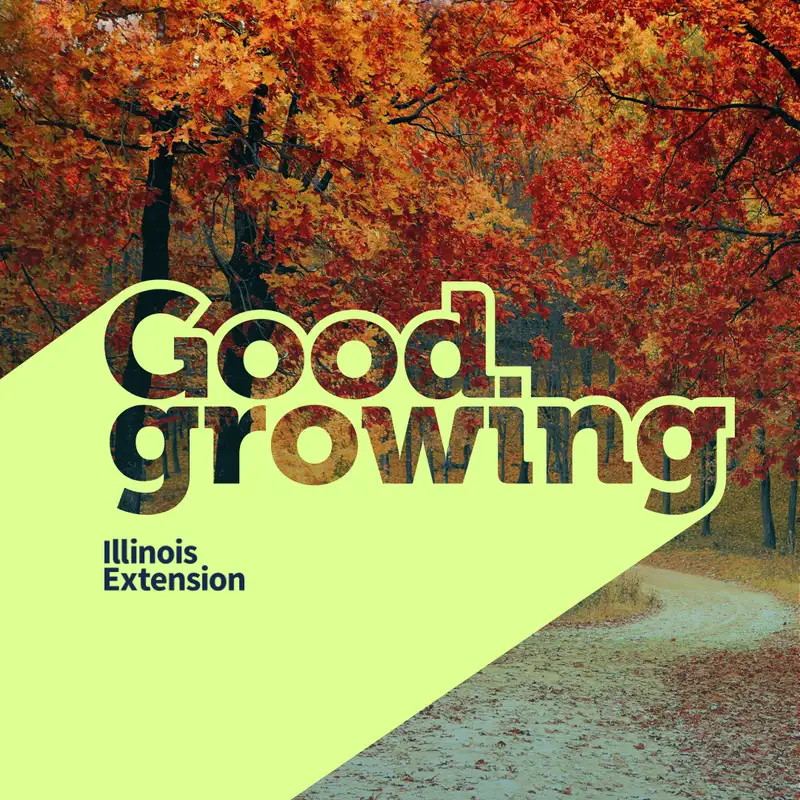Gardenbite: The Science Behind Fall Color | #GoodGrowing
00:00:00:00 - 00:00:06:02
00:00:06:14 - 00:00:34:04
Speaker 1
Welcome to the Good Growing podcast. I am Chris Enroth, horticulture educator with University of Illinois Extension. Coming at you from Macomb, Illinois. And we have got a gardenbite for you today. Let's talk about fall color and our trees. Now on the language of folklore, it was Jack Frost who was credited with spurring on the onset of fall color by pinching each of the leaves with his icy fingers.
00:00:34:06 - 00:01:01:06
Speaker 1
Of course, today we know that's not the case. But for a long time, scientists thought that the coloring of fall leaves was caused by the accumulation of waste products throughout the season, which were then revealed as the green chlorophyll pigment faded away. This, as it turns out, is mostly untrue. But there is a little bit of truth to that which we will dive into when we look at the science of fall color.
00:01:01:08 - 00:01:32:10
Speaker 1
So what really happens to create a fall leafy display? So a combination of shortening day lengths and cooling temperatures are picked up by receptors in the tree that begin to produce hormones. And these hormones are going to initiate leaf senescence. Now, senescence is the process of the leaves breaking down complex small molecules into smaller, more soluble molecules such as sugars and amino acids.
00:01:32:12 - 00:01:57:18
Speaker 1
Now these smaller compounds are then reserved by the tree for use in the spring. So resorption is where we're taking the sugars and the amino acids, and it is recovered from the leaf back into the tree. And otherwise, if the tree did do that, it would all be lost when the tree would shed its leaves at the end of the process of senescence.
00:01:57:19 - 00:02:08:03
Speaker 1
So it's a very important part. This resorption process is to recover or recoup some of that energy before it is lost to that deciduous tree leaf
00:02:08:03 - 00:02:25:03
Speaker 1
So during leaf senescence we also have the formation of the obsidian layer. Now the obsidian layer, it's a barrier that forms at the base of the leaf petrol or the leaf stalk, so to speak. And this severs the flow of materials between the leaf and the tree.
00:02:25:06 - 00:02:34:07
Speaker 1
Once that obsidian layer is complete, the leaf is now ready to fall and it's usually removed from the tree by wind or rain.
00:02:34:07 - 00:02:58:04
Speaker 1
But you haven't gotten to fall color yet. So what role does fall color play in leaf senescence? Well, it takes energy for the tree leaves to reserve or to move those soluble compounds from the leaf back into the tree, which means that the Chlorophyl still has a job to do in producing this energy.
00:02:58:06 - 00:03:10:16
Speaker 1
But as Chlorophyl is quickly degrade, even with the onset of the cool weather and shortening days, the leaf is now vulnerable to other environmental stresses like
00:03:10:16 - 00:03:12:22
Speaker 1
ultraviolet light exposure
00:03:12:22 - 00:03:30:18
Speaker 1
There might be pests that take advantage of a dying leaf and a host of other things that can be happening out there, including freezing temperatures which might halt that resorption process too soon before the tree has time to move that material back into the tree.
00:03:30:20 - 00:03:37:21
Speaker 1
So this is where the other tree leaf pigments come into play. They help to protect and give a big
00:03:37:21 - 00:03:43:22
Speaker 1
boost of energy to the leaf to restore those nutrients back into the tree.
00:03:43:22 - 00:03:55:06
Speaker 1
Now, there are a lot of pigments at play here, and we'll cover kind of some of them and they could be grouped into families and we can even look at individual types of pigments.
00:03:55:09 - 00:04:23:05
Speaker 1
But let's first look at a large group that is very common out there. And this creates the orange colors we see in the fall. And it's caused by the family of pigments called carotenoids. And one carotenoid you might be familiar with is beta carotene. This type of pigment, it absorbs blue and green light and it reflects yellow and red light, which creates sort of an orangish hue to our leaves.
00:04:23:05 - 00:04:35:22
Speaker 1
Carotenoids are present throughout the entire growing season. But Chlorophyl is green. Pigment is so overpowering that our eyes can only see the reflected green light
00:04:35:22 - 00:04:37:13
Speaker 1
and the growing season.
00:04:37:18 - 00:05:08:05
Speaker 1
Carotenoids and Chlorophyl are working together to absorb visible light energy, which is then converted into chemical energy through photosynthesis. Now, in the fall, Chlorophyl will break down more quickly, which reveals that orange color of the carotenoids. And as these carotenoid pigments continue to process energy for that resorption process. That is where we get a little bit of that boost of energy to complete that process.
00:05:08:07 - 00:05:19:00
Speaker 1
Now, some of our favorite vegetables, such as tomatoes, carrots and sweet potatoes, also get their bright oranges. Some of our yellows, even from that carotenoid pigment.
00:05:19:00 - 00:05:28:04
Speaker 1
We also have tannins, our tannins, they cause that brown and sometimes copper color we see in the fall very often in our oaks. Some of our
00:05:28:04 - 00:05:31:08
Speaker 1
hickory trees and even some beets trees out there.
00:05:31:10 - 00:05:55:07
Speaker 1
Now, tannins make leaves taste very bitter and they are considered a waste product of certain plant processes, and leaves are going to store them up as a defense mechanism against pathogens or anything that might want to feed on that leaf. This pigment is also pretty much present throughout the entire year, but again, only visible after the chlorophyl fades in the fall.
00:05:55:09 - 00:06:04:17
Speaker 1
Now, if we think about the brilliant shades of red and purple and crimson, we are looking at a pigment known as anthocyanin.
00:06:04:17 - 00:06:14:05
Speaker 1
So our fall colors of golds and oranges and even the brown or copper colors are fairly consistent from year to year.
00:06:14:07 - 00:06:51:10
Speaker 1
But anthocyanins can be a little bit unreliable. Anthocyanin forms as plant sugars are accumulate in the leaves because of that shrinking obsidian layer as that. So as that layer is constrict, eating it slowly narrows those tubes that allow that tree to resort the nutrients and we get those sugars begin to accumulate in the leaves. So the more sunlight a leaf is exposed to, the more sugar that is produced and the more sugar that accumulates in the leaf, the more anthocyanins that can be created and the redder the leaf becomes.
00:06:51:12 - 00:07:11:23
Speaker 1
Now, not all plants are genetically programed to produce anthocyanins, but in fact some will produce anthocyanins all year long, like the well-known Crimson King Norway Maple, which so proudly sports a purple dish to reddish crimson colored leaves Even in the summer months.
00:07:11:23 - 00:07:27:12
Speaker 1
Now, anthocyanins are pretty fascinating pigments. They perform multiple functions in the fall. A big thing that they do is they absorb free radicals and protect the plant leaves as it moves nutrients back into the tree.
00:07:27:12 - 00:07:34:13
Speaker 1
in the past, scientists often thought that anthocyanin production was kind of a waste of trees energy.
00:07:34:13 - 00:07:57:08
Speaker 1
but today we realized that these anthocyanins are often a response to that tree's exposure to ultraviolet light. And so, again, as that that that leaf is trying to move those those that energy back into the tree, It is more exposed to environmental stresses, one of them being ultraviolet light and anthocyanins.
00:07:57:10 - 00:08:32:09
Speaker 1
They don't usually absorb visible light. They absorb ultraviolet light and help to protect that leaf from all genetic degradation from that UV light. I think that's fascinating. They also help to promote frost tolerance, to help ensure that the leaf senescence is completed in time for the nutrients to move back into the tree. Because again, more sugar in the leaf, which is sugars, kind of nature's natural antifreeze, it gives that leaf more time to move those nutrients into the tree.
00:08:32:11 - 00:09:05:02
Speaker 1
There's also a theory among several scientists that anthocyanins red color warns away leaf feeding insects. Now, there's a lot of other pigments that we could talk about. There are flavanols, which is a type of flavanol flavonoid, and actually anthocyanins are also a type of flavonoid. But flavanol, this is responsible for yellow colors and leaves and also in other plant parts flowers, fruits, vegetables, things like that, even egg yolks.
00:09:05:02 - 00:09:13:22
Speaker 1
The question I often get asked is which autumn, what's what should we want in an autumn to produce the best fall color?
00:09:13:24 - 00:09:33:08
Speaker 1
Well, I will say that windy, rainy fall weather is not your friend. Since these conditions tend to knock down leaves before they're ready to give their full display of color, the best fall color is usually brought on by dry, sunny days and cool, but not freeze in nights.
00:09:33:08 - 00:09:41:11
Speaker 1
I like all of nature's displays. Fall color is fleeting, so get outside and enjoy some of Autumn's hues.
00:09:41:11 - 00:09:51:23
Speaker 1
that was a lot of great information about fall color and what goes into creating those different reds and oranges and purples out there this time of year.
00:09:51:23 - 00:09:56:23
Speaker 1
Well, the good growing podcasts production of University of Illinois Extension edited this week by me Kristin Ross.
00:09:56:23 - 00:10:10:07
Speaker 1
Well, Ken Johnson will be back here next week with another garden bite. But until then, listeners, thank you for doing what you do best. And that is listening. Or if you're watching us on YouTube, watching and as always, keep on growing.
00:10:10:07 - 00:10:20:05
Creators and Guests



